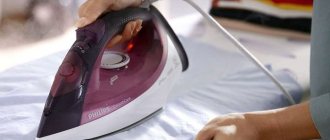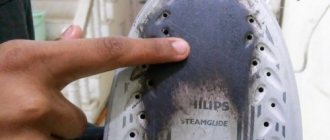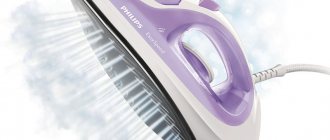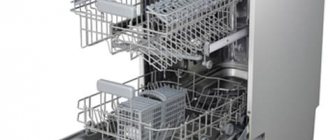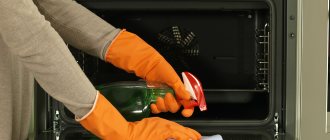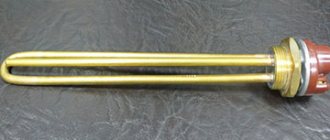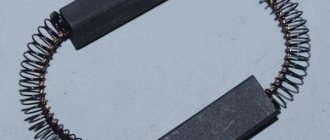We will tell you how to clean the iron from burnt marks on the soleplate at home - in our review you will find the most effective methods that can be implemented at home. We have put together a collection of useful tips that will help you get rid of burnt marks on your soles at home quickly and easily - read, study and bookmark the page so you don’t lose it!
Main rules
The occurrence of burns on the sole is not uncommon; it can be associated with forgetfulness, careless handling, or choosing the wrong temperature. It is possible to cope with the problem - it is available to everyone. Most of the products can be found in everyday life without much difficulty.
Before you figure out how to clean an iron with a soleplate at home from burnt marks, remember the following - the product is chosen depending on the surface. You should not try to clean steel, ceramics and Teflon with abrasives, so as not to damage or scratch the soleplate of the iron.
Well, now let's discuss how you can clean the soleplate of your iron at home from carbon deposits.
Products for Teflon
Teflon is considered one of the best non-stick materials. Irons with such a surface are very comfortable and multifunctional. They are able to smooth out even heavily wrinkled items. However, over time, dirt may appear on this type of surface. In this case, use the following remedies.
- Special sponges and pencils. Ideal for quickly cleaning surfaces without the risk of damaging them.
- Vinegar essence. Safe for Teflon coating and quickly removes various types of stains. You need to apply a little product to the sole and after five to ten minutes wipe it with a cloth. It is better to wear gloves when performing the procedure. For heavy soiling, dampen a cotton cloth and iron it several times.
- Soap. Suitable for treating fresh stains. When the iron has cooled down a little, you need to rub the soleplate with toilet soap and after 30 minutes wipe it with a cloth. This is the safest home method.
- Ammonia. You need to take a sponge, moisten it in a solution of ammonia and water (1:1), then wipe the contaminated areas. The iron preheats and is unplugged.
In the case of Teflon, do not use salt or other abrasives, otherwise scratches will appear.
Hydrogen peroxide
A cheap product is found in all first aid kits - it not only copes with disinfection, but also helps clean the iron from burnt marks at home:
- Soak cotton or linen material in hydrogen peroxide;
- Plug in the device, heat it up and start ironing the folded fabric.
By the way! If you do not find bottles of peroxide, you can use a hydroperite tablet:
- Dissolve the tablet in a glass of water;
- Dampen a rag with liquid and move it over a warm surface;
- Iron with a clean, dry cloth to remove any residue.
Also, be sure to read how to remove iron stains on clothes - there are also only proven methods.
How to clean the soleplate of an iron from old plaque
Only drastic measures can cope with old plaque, but it is worth understanding that overly radical methods are not acceptable.
And vinegar again: a less scrupulous, but most effective method
Wet a rag in clean table vinegar. We heat up the device, but unlike last time we don’t leave it plugged in, but turn it off after heating. Place the iron with the soleplate on a cloth and leave it for a couple of hours (ideally overnight).
After soaking, you can scrub the iron without any extra effort using a soapy solution and clean water.
Before starting work, open the windows to ensure good air circulation. Vinegar fumes are harmful to health.
Toothpaste is an assistant in the fight not only against plaque
Regular toothpaste will help clean the iron from old plaque.
To be effective, the paste must be applied to a warm surface. Rubbing is appropriate and even necessary. There will definitely be no scratches or damage. Dirt and carbon deposits will be removed along with the remaining toothpaste.
Toothpaste is an excellent cleaner. It is soft and effective. But the areas of the steam outlets should be wiped carefully so that they do not become clogged.
Dissolve old plaque with citric acid
Citric acid is truly a wonderful remedy that works effectively even with old scale.
We perform the following steps:
- Pour a liter of boiling water into a flat container.
- Dilute 5 tbsp in it. l. acids.
- Immerse the iron in the mixture so that the soleplate is just in contact with the liquid, but not completely immersed in it.
- Leave for a couple of hours.
- Wash off the carbon deposits with a soft cloth.
Watch the iron carefully so that nothing except the soleplate comes into contact with the water.
Ammonia
Ammonia will help remove carbon deposits from an iron at home. Use this proven recipe to clean burnt marks on the soleplate of your iron:
- Soak a small piece of cloth in ammonia;
- Warm up the device and wipe it with force with the material;
- Unplug and leave overnight;
- The next morning, wipe with a dry cloth.
Helpful advice. You can add a 9% vinegar solution - mix it with ammonia in a 1:1 ratio. The algorithm of actions remains the same.
We'll tell you which is the best iron with a steam generator to buy in the article, rating of 2021 models.
Solutions for ceramics
The ceramic surface heats up quickly and smoothes things well, but it is very fragile and must be handled carefully. The appearance of scratches leads to deterioration in the operation of the device, therefore, when cleaning the soleplate, do not use abrasive substances or hard brushes.
The simplest and safest cleaning method is a special pencil containing ammonia. You need to warm up the device and then turn it off. Lubricate the surface with the product. After it dissolves, wipe the sole with a soft material. If there are steam holes, you must avoid getting the substance into them. You can also use products intended for certain types of surfaces and having different compositions.
If you don’t have a store-bought cleaner on hand, use homemade recipes.
- Vinegar. You need to warm up the device well and turn it off from the network. Using a rag, apply a little vinegar to the sole. You can clean the steam holes using ear cotton swabs soaked in the product. After completing the procedure, you need to turn on the electrical appliance and iron it with a cotton rag.
- Ammonia. It is necessary to mix ammonia and water in equal quantities. Take a sponge, soak it in the solution and wipe the contaminated areas. The iron preheats and is unplugged.
- Hydrogen peroxide. You should heat the iron to maximum, wet the rag in the census and iron it well. Perform these steps until the sole is completely clean. At the end of the procedure, remove dirt from the holes. The product allows you to remove scale.
- Nail polish remover. The surface of the iron should be slightly warm. Simply wipe it with a rag soaked in nail polish remover. This method helps to remove stuck fabric.
- Lemon juice or citric acid. You need to dilute the substance with water, dip a swab into it and wipe the surface.
Ceramic and Teflon soles should not be rubbed with hard brushes or treated with aggressive substances.
Toothpaste
You can clean your iron at home from carbon deposits without scratching it using toothpaste - surely you can find a tube in the bathroom? This product can clean quite well, but does not scratch, so it is used even for “capricious” sole materials.
- Squeeze a little paste from the tube onto selected areas;
- Take a soft bristle brush and scrub the desired areas;
- Wipe off any remaining product with a damp cloth and wipe the surface with a dry cloth.
If you want to know which sole is better to choose an iron with, then follow the link.
Causes of burning
The formation of carbon deposits on the soleplate of the iron occurs due to various factors. Main reasons:
- Failure to comply with the temperature conditions recommended by the manufacturer. If you iron fleecy or delicate fabrics with a hot iron, the threads are strongly burned and melted, leaving marks on the surface.
- Using untreated water for steaming. When heated, the salts contained in it, rust particles, and the smallest metal elements splash out through the holes onto the sole and burn. The surface becomes rough, and lint and powder residues easily stick to it.
- Leaving the iron in one place for too long.
- Contact of plastic elements (fittings, buttons, lock teeth) under a hot device.
- Ironing materials with adhesive backing, varnished fabrics, polyethylene, areas with prints.
Ironing of poorly rinsed items also contributes to the formation of carbon deposits. In addition, burns may form if the iron is stored for a long time without packaging. The accumulated dust will immediately stick to the sole, creating conditions for subsequent burning of the fibers.
Soap
We recommend using laundry soap, although ordinary bar soap can also clean burnt marks. Use only for small and fresh stains:
- Grate some shavings from the piece;
- Add a little water to thin the paste;
- Using a sponge, apply it to the surface and leave for a while;
- Wash off any remaining burnt residue with a damp cloth and wipe the surface.
Finally, you can buy a special pencil in the store to clean the surface from burnt surfaces - it is inexpensive and sold almost everywhere.
We discussed how to clean your iron from carbon deposits at home - choose the option you like, now you can easily deal with the problem yourself!
Read further: Icons on laundry items and their designation - you need to know this.
Cleaning from scale and limescale
Using ordinary water leads to the appearance of scale, and as a result, deterioration in performance or contamination of items during ironing. The correct solution would be to follow the instructions and use distilled water. But if a problem has already appeared, it needs to get rid of it.
Self-cleaning function
Useful feature. Unfortunately, it is only present in new models.
Principle of operation:
- Fill the reservoir with liquid to the maximum;
- Select the maximum heating temperature on the regulator;
- At the same time, the iron will heat up and cool down several times;
- We drain the water from the tank along with loose debris and dirt.
Cleaning steam pipes
It's not just the tank that is susceptible to limescale deposits. Scale collects in the pipes and the sole of the iron. To clean them, you need to add a special powder or a special descaling liquid to the poured water. You can choose any that are sold for cleaning washing machines or kettles. The principle is the same: pour water into the tank, add a cleaning agent, heat it up and turn on the steaming mode several times. Thanks to this, not only the tank is cleaned, but all pipes are washed out with steam.
Table acids
If we talk about folk remedies, then any table acid helps against scale: acetic, citric.
The products are used in the same way as in the case of factory powder products:
- We dilute 20-50 grams of acid per glass (depending on the concentration - acetic acid is more powerful) with water and pour it into the tank.
- Turn on the heating.
- Turn on the steaming mode.
- After the procedure, rinse the iron with clean water and wipe the sole.
Soda
Let us not reveal the secret that any soda is an acid, albeit a weak one (carbonic acid, when opening the bottle, immediately breaks down into water and carbon dioxide, hence the bubbles).
Thus, if you suddenly don’t have any of the products described above at hand, you can buy a bottle of sparkling water and carry out the cleaning procedure with it.
Vinegar
This is the simplest and most time-tested method for fresh and old burnt marks. You don’t have to worry about the smell—it’s enough to ventilate the room well for it to go away.
You will need:
A few tablespoons of table vinegar and rock salt.
What to do:
In a metal bowl or saucepan, mix half and half vinegar and salt, put on low heat and wait until the salt dissolves. Be careful not to allow the vinegar to boil. Cool the mixture and wipe the surface of the iron with a soft rag or sponge. If any stains remain, leave the mixture on them for just a couple of minutes and wipe with a soft brush. Remove the remaining solution with a napkin and iron the unnecessary rags several times with a heated iron before use.
Prevention
Preventing stains is much easier than cleaning the iron from burnt-on dirt. When using the device, it is recommended:
- When ironing, observe the temperature conditions for specific items and do not overheat synthetics and delicate fabrics;
- process silk and wool through damp thin gauze;
- Do not iron worn, unwashed items; in this case, carbon deposits are formed due to dirt particles.
After each use, the cooled device should be wiped with a weak solution of citric acid. This will allow you to immediately clean the coating of the iron from carbon deposits, before the latter has time to dry, and prevent the formation of noticeable stains.
Method 6
Soak a cotton pad in acetone or vinegar and rub the working surface of the iron. After removing carbon deposits from the iron, wipe it with a piece of wool. If the carbon deposits have not gone away, then turn off the iron, let it cool slightly and place it overnight on a rag soaked in vinegar. The plaque will soften, peel off and can be removed with a soft cloth.
How to avoid burning on your iron?
The main thing is to always set the appropriate temperature for different types of fabric, and do not iron sweaters and underwear on the same setting. After use, wipe the soleplate of the iron with a soft cloth so that plaque does not accumulate and dry out. Delicate items that are sensitive to temperatures (wool, synthetics) should be ironed through the backing. Otherwise, you can ruin both your clothes and your iron at the same time, and you definitely don’t need that!
Did you like the post? Subscribe to our channel in Yandex.Zen, it really helps us in our development!
Method 10
You can also use baking soda. You need to mix it with water, soak a cotton pad in the solution and rub the cold iron in a circular motion. After this, rinse the surface of the iron with a sponge soaked in clean water and wipe with a soft cloth.
It is important to remember that you should never clean your iron with rough abrasives or a knife. This damages the working surface of the iron and can lead to further problems.
Everyone also knows that prevention is better than cure. Therefore, after each use of the iron, wipe its sole with a soft cloth.
Source: masterlomaster.samodelkinoblog.com
